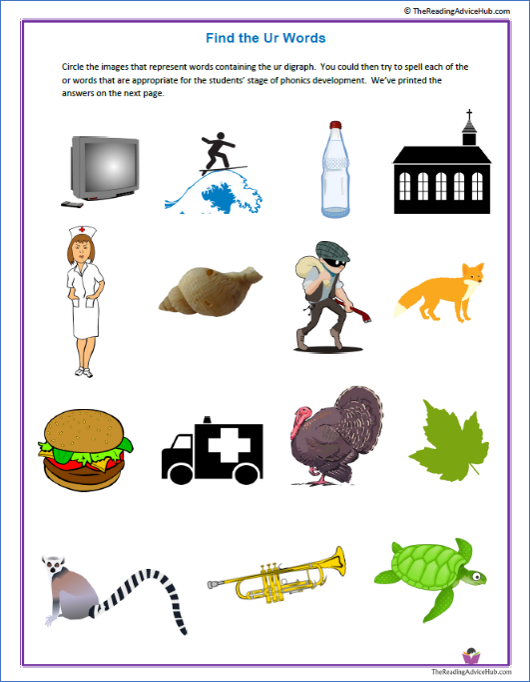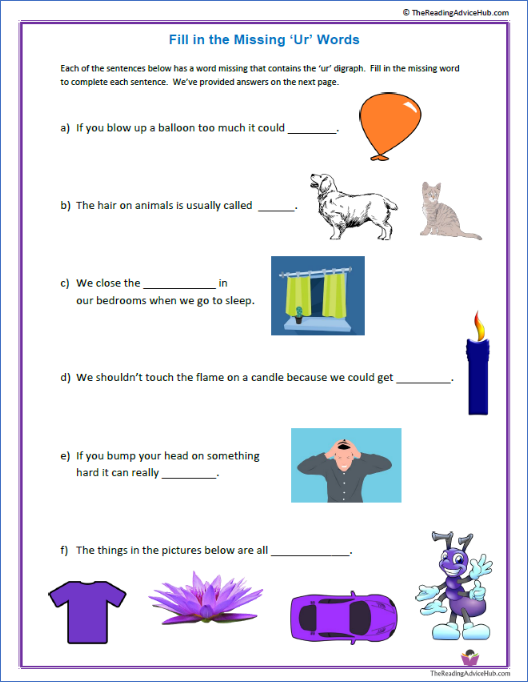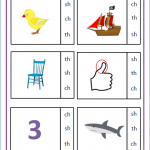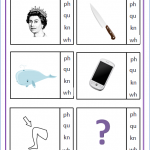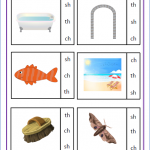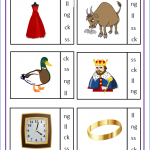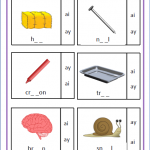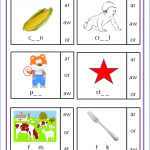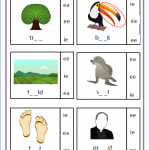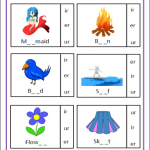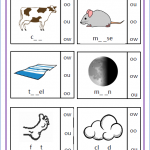Ur digraph examples, word lists, free worksheets and games for phonics teaching.
Ur Digraph Sounds
The ‘ur’ digraph is a fairly common grapheme in written English and the sound most frequently associated with the digraph is found in words such as burn, fur, hurt and nurse.
This phoneme is represented by the symbol /ur/ in popular phonics programmes such as Jolly Phonics and Letters and sounds. British English speakers normally use the International Phonetic Alphabet (IPA) symbol ɜ: for this sound, but some dictionaries represent the sound with different symbols. For example, the symbol ɝ can be used to represent the sound in American English.
Some educators and linguists describe ɝ as a murmur diphthong or an r-controlled/r-coloured vowel; however, these terms are rarely used in schools in the UK.
A number of other letter combinations can also represent the ɝ sound. For example, er, ir, or and ear in the words germ, bird, word and Earth.
Linguist Emma describes how to say the ɜ: sound in a British English accent in the video below:
The digraph can represent another sound when it appears in the unstressed part of some multi-syllable words such as survive, lemur and murmur. This might be described as an ‘uh’ or schwa sound (Ə) for British and Australian accents, but a slightly different sound and symbol (ɚ) is used in American accents.
The same sound can also be represented by other vowel digraphs that end with the letter r. For example, ar in the word dollar, er in the word tower and or in the word doctor.
Click on the following link to access our article on the schwa sound if you want more information about this.
The ‘Sounds American’ videos below give a thorough description of the alternative pronunciations of the common sounds for the ur digraph in American accents:
And the video below gives a more detailed explanation of how to differentiate between the two sounds:
There are some words where the ur letter combination doesn’t act as a true digraph because u and r represent 2 separate sounds at the boundary between 2 syllables. For example, in guru and jury.
Finally, the ur letter combination doesn’t act as a digraph when it’s preceded by the letter o in words such as our or your or the letter a in aura or dinosaur. In words like these, it forms part of a trigraph and it also forms a trigraph when it is followed but the letter e in words like sure and cure.
Teaching the Ur Digraph
The ur digraph is often taught quite early in phonics programmes. For example, it’s taught in phase 3 of the Letters and Sounds phonics programme which is broadly followed in many schools in England. This phase starts in the second half of the first term in reception when children are aged between 4 and 5 years old.
However, teachers don’t usually introduce digraphs until children can recognise individual letters and say the sounds they represent accurately and fluently.
It’s also helpful if children are able to blend and segment simple words such as CVC words and other one-syllable words before digraphs are taught.
Introduce the digraph by showing children how to decode and blend some simple examples of words from the word list below and then get them to read some words for you.
Most teachers in England introduce the digraph as the fully pronounced /ur/ sound at first, no matter where it occurs in words.
An exaggerated, fully stressed pronunciation can be helpful when children are first learning to read new digraphs and it can also help them to remember the correct spellings.
Even though their pronunciation might sound a bit robotic at first, children gradually start to recognise the letter patterns more quickly and eventually say the words in a way that’s closer to their spoken accent. However, learners who are non-native speakers of English might need a bit more support.
Point out that the digraph can represent a different sound in some words and compare words with the different sounds to highlight this.
In addition to practising reading the words, they should also practise spelling them.
If children have trouble doing this, show them how to make the words with alphabet cards. Say the sounds as you put the cards down then shuffle the cards and ask them to make up the word again.
When you are demonstrating spelling these words with alphabet cards, put the two digraph letters down at the same time as you say the sound just once.
See our articles on teaching digraphs and spelling with phonics for more guidance.
You can also use some online resources to provide variety. For example, Reading Bear has several presentations that include ‘or words’ in the purple section.
And the video below might appeal to young children as the popular Mr Thorne teaches Geraldine the giraffe about words with the ur digraph:
Ur Digraph Word List
We’ve split the lists into different sound categories in alphabetical order to help you locate words you might want to use with your students.
Initially, it can help to use words that students are familiar with, but as they get more proficient, it’s good to introduce some new words to expand their vocabulary and refine their decoding skills.
Click on the following link or the image below to download a free printable pdf version of this word list.
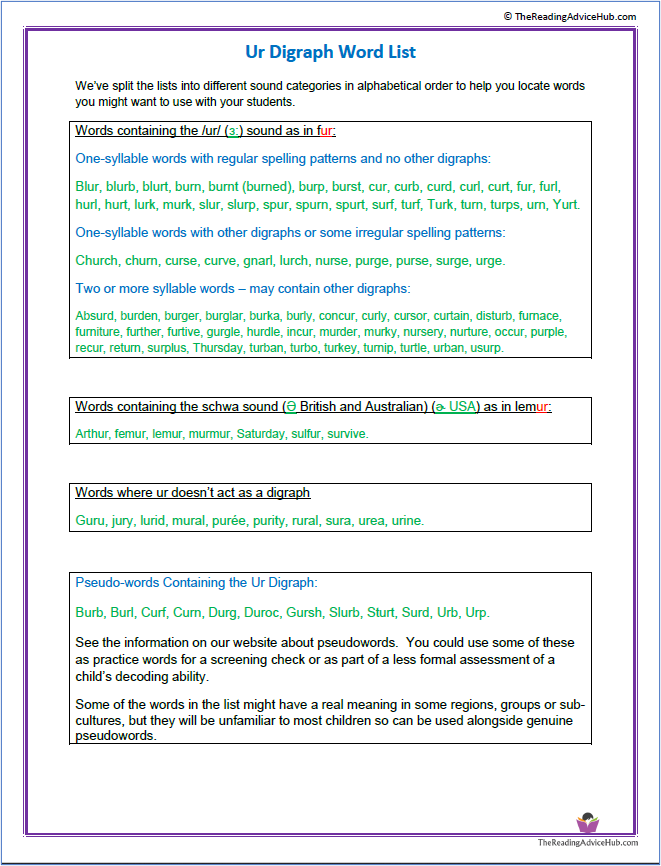 Words containing the /ur/ (ɜ:) sound as in fur:
Words containing the /ur/ (ɜ:) sound as in fur:
One-syllable words with regular spelling patterns and no other digraphs:
Blur, blurb, blurt, burn, burnt (burned), burp, burst, cur, curb, curd, curl, curt, fur, furl, hurl, hurt, lurk, murk, slur, slurp, spur, spurn, spurt, surf, turf, Turk, turn, turps, urn, Yurt.
One-syllable words with other digraphs or some irregular spelling patterns:
Church, churn, curse, curve, gnarl, lurch, nurse, purge, purse, surge, urge.
Two or more syllable words – may contain other digraphs:
Absurd, burden, burger, burglar, burka, burly, concur, curly, cursor, curtain, disturb, furnace, furniture, further, furtive, gurgle, hurdle, incur, murder, murky, nursery, nurture, occur, purple, recur, return, surplus, Thursday, turban, turbo, turkey, turnip, turtle, urban, usurp.
Words containing the schwa sound (Ə British and Australian) (ɚ USA) as in lemur:
Arthur, femur, lemur, murmur, Saturday, sulfur, survive.
Words where ur doesn’t act as a digraph
Guru, jury, lurid, mural, purée, purity, rural, sura, urea, urine.
Pseudo-words Containing the Ur Digraph:
Burb, Burl, Curf, Curn, Durg, Duroc, Gursh, Slurb, Sturt, Surd, Urb, Urp.
Pseudo-words are sometimes described as non-words or nonsense words and they’re used in some phonics programmes and in the UK Phonics Screening Check.
These words are designed to assess whether children are capable of decoding words that are unfamiliar to them.
Normally, a pseudo-word will be presented next to an image of a monster or an alien, and the child is told that the word represents the creature’s name. The examples below are from the 2017 phonics screening check.
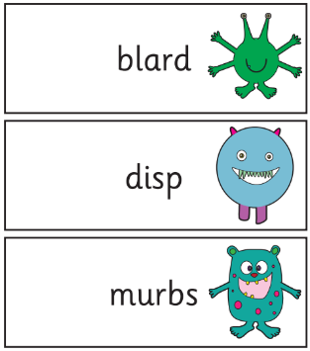
You could use some of the pseudo-words in our list as practice words for a screening check or as part of a less formal assessment of a child’s decoding ability.
Some of the words in the list might have a real meaning in some regions, groups, or sub-cultures, but they will be unfamiliar to most children so can be used alongside genuine pseudo-words.
Ur Digraph Worksheets
We’ve created the following worksheets that you to download for free. Click on the headings or the images below to access these resources.
Children need to decide which pictures represent words that contain the or digraph. They can also try to spell the words. We’ve also created a PowerPoint version of this resource if you want to display it to a class.
Each of the sentences on the worksheet has a word missing that contains the ‘ur’ digraph. Children need to fill in the missing word to complete each sentence. We’ve also created a PowerPoint version of this resource if you want to display it to a class.
Circle the Vowel Digraph er, ir, ur
Circle or write in the digraph that gives the correct spelling for each picture.
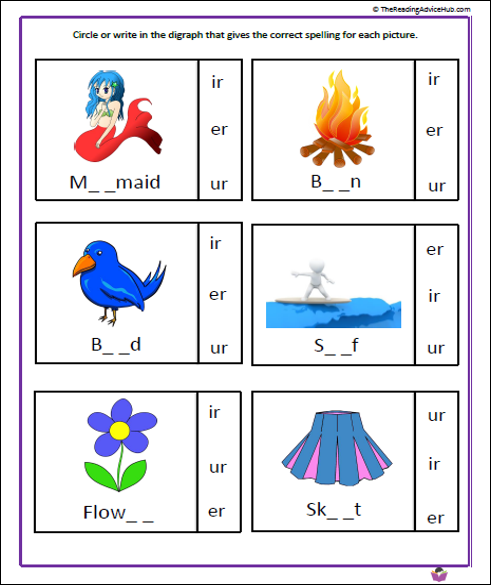
Ur Digraph Phonics Games
The spellzone website has some free games using words containing the ur digraph. They also have a variety of other games that require you to sign up and pay a subscription, but they do offer a free trial.
Click on the following link for the spellzone games:
The SplashLearn website also has some activities for practising blending and spelling or words. You have to sign up to access all the activities but it’s free to try it.
Other Free Digraph Resources
A variety of free worksheets and other resources for a number of common digraphs.
